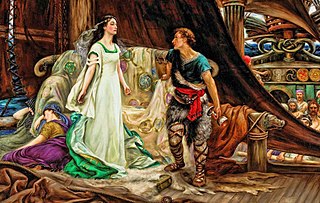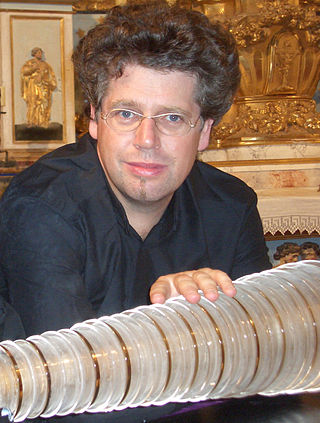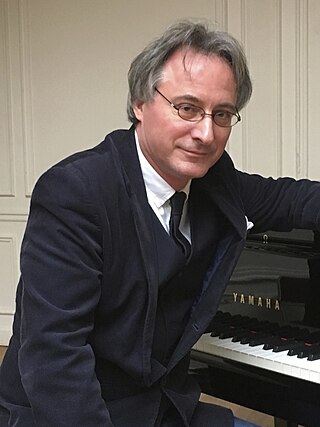
Olivier Eugène Prosper Charles Messiaen was a French composer, organist, and ornithologist who was one of the major composers of the 20th century. His music is rhythmically complex. Harmonically and melodically, he employed a system he called modes of limited transposition, which he abstracted from the systems of material his early compositions and improvisations generated. He wrote music for chamber ensembles and orchestra, voice, solo organ, and piano, and experimented with the use of novel electronic instruments developed in Europe during his lifetime.

Yvonne Louise Georgette Loriod-Messiaen was a French pianist, teacher, and composer, and the second wife of composer Olivier Messiaen. Her sister was the Ondes Martenot player Jeanne Loriod.

The Turangalîla-Symphonie is the only symphony by Olivier Messiaen (1908–1992). It was written for an orchestra of large forces from 1946 to 1948 on a commission by Serge Koussevitzky in his wife's memory for the Boston Symphony Orchestra. Along with the Quatuor pour la fin du temps, the symphony is one of the composer's most notable works.

Pierre-Laurent Aimard is a French pianist.

Tristan and Iseult, also known as Tristan and Isolde and other names, is a medieval chivalric romance told in numerous variations since the 12th century. Based on a Celtic legend and possibly other sources, the tale is a tragedy about the illicit love between the Cornish knight Tristan and the Irish princess Iseult. It depicts Tristan's mission to escort Iseult from Ireland to marry his uncle, King Mark of Cornwall. On the journey, Tristan and Iseult ingest a love potion, instigating a forbidden love affair between them.

Louise-Justine Messiaen, more commonly known under her pseudonym Claire Delbos, was a French violinist and composer, and first wife of the composer Olivier Messiaen.

Thomas Bloch is a classical musician specializing in the rare instruments ondes Martenot, glass harmonica, and Cristal Baschet.
Messe de la Pentecôte is an organ mass composed by Olivier Messiaen in 1949–50. According to the composer, it is based on twenty years of improvising at Église de la Sainte-Trinité, where Messiaen was organist since 1931.

Des canyons aux étoiles... is a large twelve-movement orchestral work by the French composer Olivier Messiaen. American Alice Tully commissioned the piece in 1971 to celebrate the bicentenary of the United States Declaration of Independence 1976.
Concert à quatre is the final work of the French composer Olivier Messiaen. It is a concerto written for four solo instruments and orchestra.
Ginette Martenot (1902–1996) was a French pianist, and an expert and leading performer on the twentieth-century electronic instrument the ondes Martenot, which was invented by her brother Maurice. At the age of sixteen, she entered the Paris Conservatory, where she studied counterpoint and fugue with the composer Arthur Honegger. She gave the first performance as solo ondist in Messiaen's Turangalîla-Symphonie, with Yvonne Loriod taking the solo piano part.

The ondes Martenot or ondes musicales is an early electronic musical instrument. It is played with a keyboard or by moving a ring along a wire, creating "wavering" sounds similar to a theremin. A player of the ondes Martenot is called an ondist.
Quatre Études de rythme is a set of four piano compositions by Olivier Messiaen, written in 1949 and 1950. A performance of them lasts between 15 and 20 minutes.
French electronic music is a panorama of French music that employs electronic musical instruments and electronic music technology in its production.

François Weigel is a French pianist, conductor and composer.
Visions de l'Amen is a suite of seven pieces for two pianos by the French composer Olivier Messiaen (1908–1992), commissioned for the Concerts de la Pléiade that were held during the German occupation of Paris. It was composed in 1943 for the composer and Yvonne Loriod, and its performance requires about 40–45 minutes.
Chants de Terre et de Ciel is a song cycle in six movements for soprano and piano by Olivier Messiaen, on text by the composer himself. It was composed in 1938 and premiered at the Société Triton's Concerts du Triton, at the Ecole Normale de Musique in Paris on the 23 January 1939 with Marcelle Bunlet as the soprano and the composer at the piano. The cycle is deeply personal and reflects Messiaen's joy at the birth of his son Pascal in 1937, as well as his deep Catholicism.

Poèmes pour Mi is a song cycle for dramatic soprano and piano or orchestra by Olivier Messiaen, composed in 1936 and 1937 and dedicated to his first wife, Claire Delbos. The text are poems by the composer based on the New Testament.
Réveil des oiseaux is a work by Olivier Messiaen for piano and orchestra written in 1953. Messiaen invoked birdsong in this composition, as he had in the earlier Quatuor pour la fin du temps (1941). In Réveil des oiseaux he used bird song motifs throughout.










